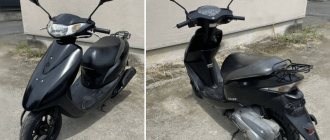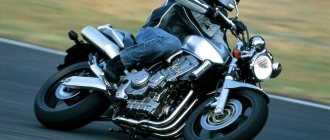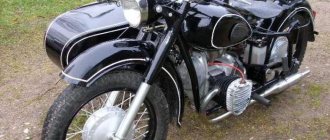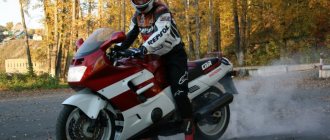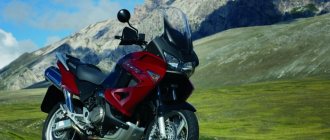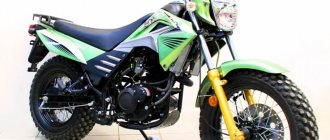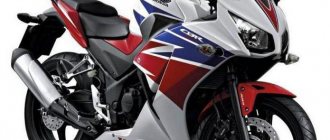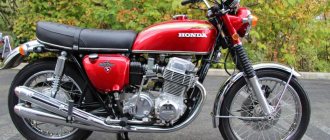The Honda CB 1000 SF heavy-duty road bike model was presented to the public in 1992. Produced until 1997. The motorcycle is equipped with an inline four-cylinder engine with a displacement of about 1000 cc. Its power is 98 hp. With. The Honda CB 1000 engine has been derated to optimize medium and low speeds. This is done to achieve smooth, confident traction at any point in the operating range.
A successful bike from the past
Despite the relatively short production period, the Honda CB 1000 model has become in demand around the world. The demand for motorcycles remains at a stable level today.
It is necessary to clarify that the Honda CB 1000 has nothing in common, except the name, with the modern naked bike “Honda CB 1000R”, which has been produced since 2007. The motorcycles are built on two different platforms and belong to different classes.
The Honda CB 1000 model is one of those rare bikes that has not been modernized over the entire production period. Only in 1994 there was an attempt to create a modification with a semi-fairing, but the motorcycle was not in demand and a year later it was discontinued.
Honda road motorcycles of the SV class traditionally have powerful power plants, the thrust of which varies between 90 and 125 hp. pp., which is enough for both effective maneuvering in urban conditions and dynamic driving on the highway. The speed that the bike can reach is 220 km/h. The cylinder volume of 1000 cc/cm more than provides the power needed for this. Of course, few owners operate a motorcycle, accelerating it to a speed of two hundred kilometers per hour. Therefore, we can expect that the resource built into the machine is preserved. The durability of the bike can be ensured by careful handling.
Review of the Honda CB 1000 motorcycle
Honda CB 1000 This motorcycle is a typical classic.
He is like this not only in appearance, but also in all other respects. Many will find both advantages and disadvantages in this. Of the latter, it is worth noting that the Honda SB 1000 is completely unsuitable for high-speed driving, although it is capable of it.
For whom
Here are the main features of the model:
- classic exterior, typical of the brightest bikes in the class;
- very comfortable fit, but only if the rider has a suitable build;
- Driving is comfortable only at low speeds without sudden movements.
Honda CB 1000 is suitable for those who want to have a classic two-wheeled car for leisurely driving. Of course, this already quite old motorcycle is a desirable piece for collectors of the best Japanese technology.
Specifications
An interesting feature of this car is that, even if it has the ability to drive fast, it categorically “does not like it.” This manifests itself in extremely sharp acceleration and “unfriendly” behavior of the model during sudden actions and high speed.
Engine
The engine here is an in-line, four-stroke and four-cylinder unit. Its effective volume is 998 cm³. It is cooled by liquid. At maximum, the engine produces 84 Nm of torque and 98 hp. power. The top speed is 220 km/h, and acceleration to hundreds will take only 4 seconds.
Transmission
The CB 1000 uses a chain as a drive. The gearbox includes five stages. This is not to say that the latter is the best option for a motorcycle; a six-speed gearbox would be more suitable for it. However, this option is sufficient.
Dimensions and weight
This is a fairly large bike with a very high center of gravity, and therefore requires some physical strength and height to control it. The seat height here is 810 mm, and the wheelbase dimensions are 1535 mm. The motorcycle is 2220 mm long, 785 mm wide, and 1130 mm high. Without fuel, the car weighs 235 kg, and with it - all 260 kg. The tank volume is quite large - 22 liters, however, fuel consumption per hundred kilometers is not small and in fact amounts to 7 liters.
Chassis and brakes
The CB 1000 has a duplex frame made of steel. The abundance of metal in the exterior immediately catches the eye. Although this is a classic motorcycle, the wheels are alloy. The steering wheel is very comfortable and has traditional dimensions for this class.
As for the suspension, at the rear there is a pendulum version with a double shock absorber, at the front there is a 43 mm telescopic fork. This is a completely natural solution for the class.
The rear brake is a 276 mm disc with a single-piston caliper, and the front is a pair of 310 mm discs with four-piston calipers. It is these components of the bike’s chassis that react particularly sharply to sudden changes in speed and other sporting habits of the rider.
Power point
The power plant parameters are as follows:
- working cylinder volume - 998 cubic cm;
- number of cylinders - 4;
- location - in-line;
- maximum power - 98 hp. With. at a rotation speed of 8600 rpm;
- torque - 82 Nm at 6200 rpm;
- compression - 10;
- cylinder diameter - 77 mm;
- piston stroke - 53.5 mm;
- cooling - water;
- power supply - four Keihin carburetors, 34 mm diffusers;
- ignition - contactless, electronic;
- Fuel consumption is 6.5 liters per 100 km.
Review of the Honda CB 1000 motorcycle (CB1000SF, Big One)
An hour after studying the appearance of my “Shiba” I decided to go for a ride. I rolled out this heavyweight, took a breath, started it and drove for the first few meters at idle, gave it a little gas and a pleasant heaviness throughout the body, no wild grabs or wheelies, just a high-speed lift with direct traction. I’m driving and thinking, they scared me like a liter, a hundred mares, I need to have experience. Guys, you need to have an instinct of self-preservation and not become impudent after the first thousand, otherwise a liter will put you in your place. Mot is very kind and sympathetic, he swallows bad coverage and the mistakes of a beginner, but if you make him angry (trying to feint in front of girls) and turn the handle more sharply than necessary, you can get in the ass) at best. In general, I fell in love with him and now I’m as happy as an elephant.
So, I managed to screw it up on the first day by 5 cm, when, out of inexperience, I abruptly dropped the clutch (not on purpose). A couple of times I was driving (don’t drive behind gazelles and similar vans, the visibility should be at least 5 cars ahead), I thought I was driving the car, and blew the rear brake to the limit, but my bike forgave me for that, otherwise I wouldn’t have written this article, but at the very least I would be lying in the hospital, and at the maximum... The engine is a carburetor, it must be warmed up, otherwise it won’t run. The brakes are hard, especially the front ones, so I brake with everything at once, with speed, switch to lower and with both brakes, it took me a while to get used to it, but there’s no other way. Despite the windshield, after 140 it starts to blow away, although my friend gave it 160 without a helmet and said that it didn’t even blow into his eyes (maybe he was showing off, or maybe he praised, x/s, I personally tell my impressions), potholes on the roads to him also no problem, rooted to the spot! The speedometer needle goes down without any problems, in short, I don’t know how much I accelerated it, but it was really scary, the speedometer shows 180 and a couple more divisions, then the limiter stops the needle. This pampering is not on our roads!!! But he doesn’t eat like a child! I was unpleasantly surprised when the odometer showed 243 km (I specially reset the odometer and filled the tank full) but it started to build up and eventually stalled. I drove to the gas station on reserve and filled up with 20 liters. The result is 8.2 liters per 100 km in mixed mode, but you can’t do anything, a liter is a liter, you have to pay for comfort. But I think, if you don’t anneal it, don’t knock the needle, then it will easily get to 6-7 liters per hundred!
By the way, the shock absorbers are cool, impenetrable, 160 kg (two men) pulls with a bang, and even if you grunt on the next bump on our “mirror-smooth” roads, you won’t be able to wait!!!
It takes turns with a bang, without a knee of course, but confidently, but don’t accelerate the current, otherwise it will break, a liter after all! And finally, you only need to turn the throttle when you know what you want from it!
Motsik is very kind, it’s like sitting on grandma’s lap! It forgives mistakes, especially for those “much experienced” like me! He doesn’t tolerate showing off, an acquaintance knocked him down right away, as he wanted to burn rubber, fortunately the arcs were there, so he didn’t lose any sales! My friend, after the ride, said “there’s no highlight, well, he just goes on and on.” For me, this motorcycle is just right, I didn’t make a mistake with either the brand or the volume, the traction is simply locomotive, I started off from the second (first) and didn’t even feel any sales.
Yes, it’s a little heavy, but for the first 2 days, then you get used to it so much that 125s and 250s actually seem like scooters. I don’t advise you to take anyone weighing less than 60 kg, just don’t lift it when you fill it up! I'm 75-80, height 185, not a SchwarzNEGRA of course, but I can lift it normally, that is, without smell from the back :) When you go onto a dirt road, you immediately feel all its weight, but on the road it’s like on a bicycle, and it can start no worse than a sport . Box, sales have nothing to compare, I can’t say anything bad about the Yamaha, but a Honda is a Honda, clear and understandable!
In general, a worthy device for a beginner, and also great for an old-timer, especially who doesn’t need 200 km/h in 5 seconds... For long-distance travel it’s just super, 250 km with a cruising speed of 120 km/h (that’s what I have) without even thinking about it, You don’t get tired one bit! In short, 1000 km in 3 days, happy as a giraffe!!!
The motorcycle is heavy, weighs about 250 kg when fueled. At about zero speeds it’s a little hard to steer, so I had to get used to it in the evenings and at night. The weight distribution does not allow you to accidentally skid-170 mm. the wheel just breaks into the axle box (I haven’t tried it on purpose). During emergency braking, the front wheel is blocked and you will not be able to fly over yourself. This is what got me down in the wet weather, when the road was blocked by the idiot. I had to brake to the floor and roll onto my side(((. The speed was low, about 60 km/h, and therefore the damage was minimal. Repairs cost 10,000 rubles and the purchase of arcs at Crazy Iron for 4,200 wooden ones.
In terms of taxiing, apart from the fact that it is a bit heavy at low speeds, everything else is fine. I am 192 cm and 95 kg. He transports all this easily. Seating a passenger is also not a problem. Naturally, a carb bike needs to be warmed up. Then he drives normally, without failures (some complained about them). Maximum speed 180 km/h. It already seems like not enough, but our roads and common sense say that it’s enough. I still can’t afford to install the glass, otherwise it’s already sailing at 130-140. It flutters like a sheet in a hurricane)))).
Fuel consumption??? - how to turn the knob))) - from 6 liters to 10 per hundred. A tank of just over twenty liters is enough.
Okay, I’ve written so much and would write more)))… The main thing is not to overclock the gas on a wet road and not to block the front wheel. On a dry road, even with the skid wheel locked, you won’t fall if there is no sand, pebbles and other rubbish...
I liked the motik. The other day I wanted to sell and take the blackbird, but I won’t do it. The blackbird will wait a little))))
Honda CB1000 is something! I know a lot of people will disagree with me, but I think it's just a cool motorcycle. Of course, every owner believes that his machine is the best. I don’t think so, I just pay tribute to this very good motorcycle in all respects.
However, let's take things in order. What is SV1000? It is a water-cooled inline four with a displacement of 998 cc. and a power of 98 horses. My Japanese version seems to me to be slightly stifled in power, but knowledgeable people say that this can be easily fixed by replacing the “brains”. Moreover, the Japanese version has a speed limit of 190 km/h, although this can be eliminated. The European and American versions of this motorcycle are more powerful (which doesn’t hurt), and have a maximum speed of 245 km/h. I don’t think that such speed is necessary for the naked neoclassic that the SV1000 is, although it will certainly achieve it with ease. Together with Monika, I put the speedometer needle on our SV, but at the same time I had to literally squeeze into the tank. Maybe if there was a front shield it would be different, I don’t know...
The motorcycle is quite heavy - 250 kg. At the same time, it has a fairly high center of gravity, which makes it quite difficult to hold it in a tilted stationary position. In appearance it is simply huge. Although it is smaller in volume than the Yamaha XJR1300, it feels taller, wider, heavier and bulkier. However, on the move it becomes almost unnoticeable. The motorcycle takes turns easily, the slight tilt of the steering wheel makes maneuvering easy and fast. However, on a closed track such as the karting track in Mytishchi, considerable weight and a high center of gravity become noticeable very quickly. After making one or two circles, you begin to get tired. Although the SV1000 confidently and easily navigates steep turns, the weight begins to greatly tire the arms. After all, this is not a sportbike! If you go long distance, this problem becomes invisible.
The motorcycle is very obedient and forgives many of the driver’s mistakes. The power curve is almost linear, which is why many professionals call it boring: you always know exactly how the bike will behave. I drove it in the rain and I have to say that I didn't notice much of a difference in performance. It stands like a glove, and only with sharp braking or switching to lower gears is the rear wheel likely to fall off. In other cases, there is not the slightest fear that the wheels will lose traction.
The brakes are brutal! I can’t say anything good or bad about the rear. They brake as best they can, but it’s better not to overdo it. The weight of the motorcycle is such that it instantly skids if the rear brake is used excessively, but it carries straight, so this is not the most serious problem. The front brake is a powerful double-disc brake that grips smoothly, making braking easy to control, but at the same time strong. I tried to brake sharply at 150 km/h - the effect was amazing. Without losing contact with the road, the motorcycle literally digs into the asphalt. At the same time, it is quite difficult to hold on, since the driver is forcefully pressed into the tank and has to firmly press against the steering wheel so as not to be thrown out. There is a plus to this - during emergency braking, you know for sure that you will stop on time :).
The gearbox deserves special attention: the gears are engaged with a knock, but very smoothly and clearly. Finding neutral is not a problem at all. The gears are arranged, in my opinion, optimally. Regardless of the number of revolutions when upshifting, the engine grabs smoothly, without jerks or dips. It can be cranked up to the redline at 8,500 or switched to 2,000. In any case, there is enough traction for confident and smooth acceleration. I drove in 5th gear at 45 km/h, and there was no feeling that the engine was about to choke. When the throttle was turned sharply, there was a barely noticeable delay, the motorcycle seemed to think what to do, and then began to confidently and smoothly gain momentum until the maximum limited speed of 190 km/h.
It's also very easy to anneal on the spot. Many times, standing at the next traffic light, I effortlessly smoked the rear wheel in both first and second gear. I don’t recommend releasing the front brake at this moment without the skill - the motorcycle stands up like a candle and breaks away - breaks out aggressively! - from the hands. However, it’s not very easy to get out of a place alone - considerable weight takes its toll. However, with two people it’s easy – oh the miracles of weight distribution! – you just have to accelerate slightly, and you’re already riding on the rear wheel, helplessly turning the steering wheel.
The suspension of the motorcycle is soft, comfortable, and does not tire or strain you during daily driving around the city. Small bumps and holes are hidden, but I don’t recommend flying into holes at speed - it breaks the shock absorbers. Also because of this, on high-speed sharp turns there appears a barely noticeable swaying of the motorcycle, as if wobbling. When installing a steering damper, this effect becomes almost invisible.
What else can you say about this motorcycle? Of course, it is not for beginners. It has its own, completely definite character, and in order to ride it safely and get maximum pleasure, you need to get used to it. He consumes little fuel - 6-7 liters per hundred. The location and convenience of instruments and switches is very convenient; you don’t need to get used to them. Everything happens instinctively. Like any other Honda, the SV1000 looks beautiful due to the high-quality drawing and execution of all components and parts. The only drawback is the terrible seat. Well, I don't like it. For a passenger, it’s just right: comfortable, wide, soft, although a little high. The driver's part goes under a fairly high tank, which is why when braking, as well as in the pits, you hit the tank at a certain point. Not very pleasant, I tell you. Otherwise there are no complaints. The motorcycle is cool, strong, obedient, comfortable. In short, for those who like heavy classics.
Transmission
Honda CB 1000 road motorcycles are equipped with a five-speed gearbox. Multi-disc clutch in oil bath. Gears are switched semi-automatically. The rear wheel drive is a chain drive, equipped with a double-sided tensioner.
When adjusting the chain tension, it is recommended to use a special limiter, which ensures that the drive is evenly positioned relative to the longitudinal axis of the motorcycle.
Honda CB 1000
Information on the Honda CB 1000 motorcycle
Model of the classic road motorcycle Honda CB 1000 Super Four
first appeared in 1992 and was produced until 1997. The motorcycle is powered by a 4-cylinder in-line liquid-cooled engine with a capacity of almost 1000 cc. see and producing 98 hp. power (84 Nm of torque). Unlike sports “liters”, the Honda CB 1000 engine was derated, due to which it was possible to significantly increase torque at low and medium speeds, ensuring smooth, confident traction throughout the entire operating range.
Despite the rather short production period, the Honda CB 1000 model has won many fans around the world, thanks to which this motorcycle is in high demand to this day. In 1998, replaced by the Honda CB 1000
an updated version of the motorcycle arrives -
Honda CB 1300
.
It is also important to note that the Honda CB1000 model has nothing in common with the modern naked Honda CB1000R
, which has been produced since 2007. Despite the similarity of names, these are completely different motorcycles, built on different platforms and belonging to different classes.
The main competitors of the Honda CB 1000 in the class:
- Kawasaki ZRX 1100
/
Kawasaki ZRX 1200
/
Kawasaki Zephyr 1100 - Suzuki GSF 1200 Bandit
/
Suzuki GSX 1200 Inazuma - Yamaha XJR 1200
Brief history of the model
Throughout the entire production period, the Honda CB 1000 model remained virtually unchanged. Only in 1994 was a version with a semi-fairing introduced, which was later abandoned (in 1996).
Names and frame numbers of motorcycles depending on the year of manufacture:
- 1992-1993 – Honda CB1000FP, frame number: SC30-1000001.
- 1994-1995 – Honda CB1000FR, frame number: SC30-1100001.
- 1996-1997 – Honda CB1000FT, frame number: SC30-1200001.
Specifications
| Model | Honda CB 1000 Super Four (Big-1) |
| Motorcycle type | road (classic) |
| Year of issue | 1992-1997 |
| Frame | steel duplex |
| engine's type | 4-cylinder, 4-stroke |
| Working volume | 998 cc cm. |
| Bore/Stroke | 77 mm x 53.6 mm |
| Compression ratio | 10,0:1 |
| Cooling | Liquid |
| Number of valves per cylinder | DOHC, 4 valves per cylinder |
| Fuel supply system | 4 Keihin carburetors, 34 mm |
| Ignition type | electronic |
| Maximum power | 98 hp at 8500 rpm |
| Maximum torque | 84 Nm at 6000 rpm |
| Transmission | 5-speed |
| type of drive | chain |
| Front tire size | 120/70-18 |
| Rear tire size | 170/60-18 |
| Front brakes | 2 discs 310 mm, 4-piston calipers |
| Rear brakes | single disc 276 mm, 1-piston caliper |
| Front suspension | 43 mm telescopic fork |
| Rear suspension | double shock absorber (preload adjustment) |
| Length | 2340 mm |
| Width | 785 mm |
| Height | 1130 mm |
| Wheelbase | 1540 mm |
| Seat height | 810 mm |
| Acceleration to 100 km/h | 4.0 sec |
| Maximum speed | 226 km/h |
| Gas tank capacity | 22 l |
| Motorcycle weight (dry) | 236 kg |
Fuel consumption
Average fuel consumption on a Honda CB 1000 is approximately 6-7 liters per 100 km. The exact value depends on your riding style.
The price for a Honda CB 1000 Super Four (Big-1) in good technical condition, without mileage in the Russian Federation, is in the range of $3000-3500. The price for models with mileage in the Russian Federation starts from 115,000 rubles.
Repairability
Considering the high technology of the bike and its design features, repairs in makeshift conditions, garages, and sites are not allowed. Some assemblies and components are assembled on the motorcycle using thermal pressing, this is done so that there are fewer bolts, screws and nuts in the fastenings.
But precisely because of the thermal method during repair, in order to remove any part, special dismantling devices that work under pressure are needed. A hydraulic press can only be used in specialized workshops.
A motorcycle in need of repair, replacement of parts and mechanisms is not cheap, but the main amount consists of payment for the work of qualified specialists. Spare parts are inexpensive, and new parts are available at any time, throughout the territory where the company has dealers. Thus, repairing a Honda 1000 will cost an amount not exceeding the usual average costs for such an event.
Motorcycle CB 1000SF-T2 1994 (Japan): technical specifications, photos, videos
Individual selection and sale of motorcycles from auctions in Japan and America
We work all over Russia
Honda motorcycle catalog
| HONDA CB1000 in the catalog | All HONDA models |
| Model: | Type: | Year of release: | Horsepower: | Volume: |
| CB1000 | roadster | 1994-2007 | 98 | 998 |
Riding the Elevator Test
text from MotoReview: Denis Davydov
Honda CB1000: 998 cm3, 98 hp, 195 km/h, $4200-5300, 1994
The device is of Japanese origin, which is natural for a second-hand store.
From the very first kilometers I began to associate a motorcycle with a high-speed elevator, which was put on the spot by some crazy designer. Hyper acceleration that makes the bike rear up? Convulsively clicking gears just to stay at peak power? No, this is not about the CB1000. Just turn the throttle and a pleasant heaviness spreads throughout the body. I was especially pleased with the second gear, which easily made it possible to start from a stop and accelerate well beyond a hundred.
Intensive use of the bike quickly revealed one unpleasant feature in its ergonomics: the complete absence of a fuel quantity control system. There is no level indicator, or even a control lamp. This would be forgivable in an enduro bike, which doesn't often find itself in a stable horizontal position anyway. But not for a road bike. Of course, there is always insurance in the form of a reserve, but this also has its difficulties. The fact is that the valve for switching to reserve, located on the left side, is closed by the driver’s thigh while driving.
Winter has flown by in anticipation of the new season, and now it has finally arrived. It's time to prepare the motorcycle for long journeys. This is where the time has come to stand in awe of the design genius of Honda engineers. Of course, I am not a mechanic, but, nevertheless, I will take the liberty to say that the CB1000 is one of the most convenient motorcycles to maintain. To replace the air filter, you don't have to touch the gas tank; the filter box is located under the decorative side panel, which is held in place by only one bolt. To replace the shock absorber fluid, special drain holes are provided in the front fork. Agree that unscrewing two drain bolts is much easier than dismantling the fork stays and taking a long time to shake out the remaining old oil from them. And finally, the gas tank mounting mechanism! In order to get to the thermostat or replace spark plugs, it is absolutely not necessary to remove it. The design is reminiscent of a car hood. The small locking bolts are unscrewed, the tank moves back, and its front part rises up. A special support is provided to hold the tank in a raised position. In general, I would like to say a big thank you to Japanese engineers for their comprehensive care for the consumer.
But it wasn't without problems. Moreover, where they were not expected. The first one occurred when replacing spark plugs. The diameter of the spark plug channel turned out to be too small for a standard 18 spark plug wrench made by Kingtony. I had to look for a thin-walled key made from a tube. The second problem is much more serious, and is still awaiting its solution. We are talking about the leading sprocket. The old one had sufficient output, and I decided to replace it. When I tried to install a new sprocket, which I ordered from the European Honda catalog, I discovered that it did not fit the chain. A closer inspection showed that the purchased sprocket was designed to use a 530 type chain, while the type installed on the motorcycle was 525. Further communication with the manager of a motorcycle parts store revealed a disappointing truth: European-assembled motorcycles use 530 type chains, or 520 type chains as an alternative. The Japanese origin of the bike made itself felt. As a result, I left everything in the same place and began to mentally prepare for the purchase of a new chain and driven sprocket.
Continuing the description of the differences between the Japanese and European modifications of the CB1000, I will note the absence of a mini-back behind the passenger seat for the “Japanese”. It would seem like nothing. But this trifle did not allow me to order and install a hard case, since the design of cases for the CB1000 involves the use of attachment points for this very backrest.
I would like to end the “screwdriver” topic with the most pleasant and least labor-intensive episode. At some point, a technically insignificant, but aesthetically important little detail began to irritate me: the appearance of the standard sound signals located under the headlight. Black painted wheels surrounded by shiny metal parts looked more than unpresentable. I installed a pair of higher power chrome Nikko Horns and it was not only nice, but useful. The increase in sound intensity had the most positive effect on the speed of the fathers of families’ rebound from the trajectory of movement.
The final formation of my opinion about the motorcycle was facilitated by a raid in Europe this summer. And the most important advantage for me was its reliability. One of my friends' motorcycles had oil-eating problems, and another suffered from engine overcooling. My device has not let me down in any way. I think that the key to this reliability is the simplicity and refinement of the design, as well as the undeniable quality of Honda products, enhanced by Japanese assembly. There is no need to talk about the CB1000 motor at all; the nickname “indestructible” has long been attached to it. On the way, I had the opportunity to compare the driving performance of my device and the Yamaha TDM850. Of course, any expert will say that the TDM has much better handling, because its design is more progressive. But personally, I didn’t like this flexibility. On the other hand, the CB1000 holds its course well due to its mass (dry weight - 235 kg) and is not so susceptible to crosswind impacts due to the lack of plastic lining. And the fact that you have to put a little pressure on it to enter a turn is even nice. In general, it is clear which side my sympathies are on.
Fuel consumption: 6.5 liters per 100 km for the urban cycle. Naturally, as the speed increases, the consumption increases and at a speed of 150 km/h it reaches 10 liters. On the polished European roads it is convenient to test the motorcycle in various speed modes. The speed of 140 km/h is reached in one breath. In the range of 140-180 km/h, the acceleration dynamics remain quite vigorous, but with a further increase in speed they disappear. It is claimed that vehicles imported from Japan have speed limiters that start working when they reach 180 km/h, but I can neither confirm nor deny this opinion. I didn’t feel any specific changes after overcoming the threshold. However, the speedometer is indeed calibrated to this magic number. The maximum speed that I managed to achieve was approximately 195 km/h (the speedometer needle was already in the black zone). It may not be the limit, but by this point the vibrations on the steering wheel and the impacts of the air flow become so strong that everything becomes blurry in your eyes. Prudence prevails: this motorcycle is not designed for such speeds.
It's designed for a little bit of everything: driving quickly through a crowded city or going on a long journey, and, if necessary, leaving that road and making your way along a forest path. It's a compromise, but a compromise with a capital C.
Operational features of the model
Controlling the motorcycle does not present any difficulties; the main attribute is the gas handle, which has a significant power reserve of almost one and a half turns. The movement of the device is extremely soft and responds to the slightest effort.
The high elasticity of the engine and a large power reserve make it possible not to have to change gears every second. You can move at low speed, for example, in traffic on city streets, even in second gear, even in fifth. The reason for this convenience lies in the technical parameters of the Fireblade motor, which is ideally designed and derated to reduce power. In addition, the standard engine's transmission ratios have been changed so that operation is dominated by mid- and low-speed rpms across the widest possible range.
Honda CB 1000 SF
Brief review of Honda CB 1000 SF
Honda CB 1000 SF is a classic motorcycle produced in the 90s of the last century. It is a typical “road bike”, that is, a balanced motorcycle without pronounced features, practical and moderately versatile. Powerful enough to keep experienced motorcyclists busy, it was equipped with a detuned engine and had smooth traction throughout the entire rev range. The Honda CB 1000 SF was not produced for very long, but during this time it managed to gain considerable popularity, and is still in demand in the secondary market.
In many ways, the motorcycle is similar to the CB 1300 SF model, and in general it differs little from other similar motorcycles of the same class from other manufacturers produced in the same years. It is also worth noting that it should not be confused with the Honda CB1000R model, a modern naked bike, since these motorcycles have nothing in common except a similar name. CB 1000 SF is an ordinary “classic” with a simple and fairly budget-friendly design. For a beginner, it can be called too powerful and too heavy, but it is perfect for more experienced motorcyclists who want to acquire more powerful equipment, but for one reason or another do not have significant funds to purchase.
Similar motorcycles:
- Yamaha XJR 1200
- Yamaha XJR 1300
- Suzuki GSF 1200 Bandit
- Suzuki GSX 1200 Inazuma
- Kawasaki ZRX 1100
- Kawasaki Zephyr 1100
- Honda CB 1300 SF
Technical characteristics of Honda CB 1000 SF
- Years of production: 1992-1997
- Class: road
- Frame: duplex steel
- Engine: 4-stroke, 4-cylinder, in-line
- Engine capacity, cubic meters see: 998
- Cooling: liquid
- Valves per cylinder: 4
- Fuel supply: 4 carburetors
- Power: 98 hp (at 8500 rpm)
- Torque: 84 Nm (at 6000 rpm)
- Maximum speed, km/h: 225
- Acceleration from 0 to 100 km/h: 4 seconds
- Transmission: 5-speed
- Wheel drive: chain
- Front tire: 120/70-18
- Rear tire: 170/60-18
- Front brakes: 2 discs 310 mm, 4-piston calipers
- Rear brakes: 1 disc 276 mm, 1-piston caliper
- Front suspension: telescopic fork
- Rear Suspension: Dual shock absorbers with preload adjustment
- Gas tank volume, liters: 22
- Fuel consumption at 110 km/h, liters: ~7
- Dry weight, kg: 236
Pros and advantages of Honda CB 1000 SF
- Simple and reliable design
- Sufficient power reserve for all occasions
- Comfortable classic fit
- Very comfortable standard seats
- Capacious gas tank
- Gripping brakes
Pros and cons of the Honda CB 1000 SF
- The frame is quite soft and does not allow you to ride aggressively.
- In the event of a fall (and the absence of protective bars), the engine covers will inevitably suffer
- When driving aggressively, the brakes overheat (this can be eliminated by installing reinforced brake hoses and good pads)
- Suspensions that are too soft sometimes break through on road irregularities (this can be eliminated by installing progressive springs and pouring harder oil into the fork)
- Lack of wind protection
Driving performance
The motorcycle's suspension is a little stiff, calibrated for active use. However, at the same time, it quite effectively extinguishes small potholes and bumps. In addition, the existing set of settings for the front suspension and damper fork allows you to adjust it according to your own preferences. The same can be said about the rear pendulum suspension with a monoshock absorber, which is also adjustable with an amplitude of 120 mm.
A noticeable drawback during the operation of the bike is the low ground clearance. Even a low curb can become an obstacle for a motorcycle to exit. The muffler pipes will inevitably be dented. This circumstance should be taken into account and other ways of exit should be looked for.
The maneuverability of the Honda 1000 motorcycle is excellent, the machine is obedient and responds to every movement of the biker. Confidently turns into turns even when the speed is higher than the permissible speed. It turns out not to be a turn, but a bend, but this driving style suits most owners.
Review of the Honda CB 1000 motorcycle
Honda CB 1000 This motorcycle is a typical classic. He is like this not only in appearance, but also in all other respects. Many will find both advantages and disadvantages in this.
Of the latter, it is worth noting that the Honda SB 1000 is completely unsuitable for high-speed driving, although it is capable of it.
For whom
Here are the main features of the model:
- classic exterior, typical of the brightest bikes in the class;
- very comfortable fit, but only if the rider has a suitable build;
- Driving is comfortable only at low speeds without sudden movements.
Honda CB 1000 is suitable for those who want to have a classic two-wheeled car for leisurely driving. Of course, this already quite old motorcycle is a desirable piece for collectors of the best Japanese technology.
Specifications
An interesting feature of this car is that, even if it has the ability to drive fast, it categorically “does not like it.” This manifests itself in extremely sharp acceleration and “unfriendly” behavior of the model during sudden actions and high speed.
Engine
The engine here is an in-line, four-stroke and four-cylinder unit. Its effective volume is 998 cm³. It is cooled by liquid. At maximum, the engine produces 84 Nm of torque and 98 hp. power. The top speed is 220 km/h, and acceleration to hundreds will take only 4 seconds.
Transmission
The CB 1000 uses a chain as a drive. The gearbox includes five stages. This is not to say that the latter is the best option for a motorcycle; a six-speed gearbox would be more suitable for it. However, this option is sufficient.
Dimensions and weight
This is a fairly large bike with a very high center of gravity, and therefore requires some physical strength and height to control it. The seat height here is 810 mm, and the wheelbase dimensions are 1535 mm. The motorcycle is 2220 mm long, 785 mm wide, and 1130 mm high. Without fuel, the car weighs 235 kg, and with it - all 260 kg. The tank volume is quite large - 22 liters, however, fuel consumption per hundred kilometers is not small and in fact amounts to 7 liters.
Chassis and brakes
The CB 1000 has a duplex frame made of steel. The abundance of metal in the exterior immediately catches the eye. Although this is a classic motorcycle, the wheels are alloy. The steering wheel is very comfortable and has traditional dimensions for this class.
As for the suspension, at the rear there is a pendulum version with a double shock absorber, at the front there is a 43 mm telescopic fork. This is a completely natural solution for the class.
The rear brake is a 276 mm disc with a single-piston caliper, and the front is a pair of 310 mm discs with four-piston calipers. It is these components of the bike’s chassis that react particularly sharply to sudden changes in speed and other sporting habits of the rider.
Production
The model was produced from 1992 to 1997, receiving some recognition, but it did not receive the laurels that some other bikes received.
But you shouldn’t write this down as a minus, because statistics speak not only about the quality of the motorcycle, but also about the preferences of potential buyers.
Classmates
All three motorcycle giants of the land of the rising sun have released their own model that can compete with the CB 1000. Yamaha presented the world with the XJR 1200, Suzuki showed off the GSF 1200 Bandit, and Kawasaki released the ZRX 1100.
History of changes
During its career, the motorcycle went through several stages:
- 1992 – start of production;
- 1993 – the bike begins to be exported;
- 1997 is the last year of his career.
The CB 1000 is an excellent model for its niche. It is difficult to imagine a more typical representative of the classical movement.
Comfort level
The model was originally created for a motorcyclist of average build, so a person taller than one hundred and eighty centimeters experiences certain inconvenience when riding a Honda 1000 due to the relatively short distance along the handlebar-trunk line.
For a biker of normal height, the fit seems quite comfortable. The flat-shaped seat is comfortable, the knees are placed in special niches of the fuel tank, the hands hold the steering wheel in the optimal position, without the slightest strain. This landing allows you to travel hundreds of kilometers without stopping.


